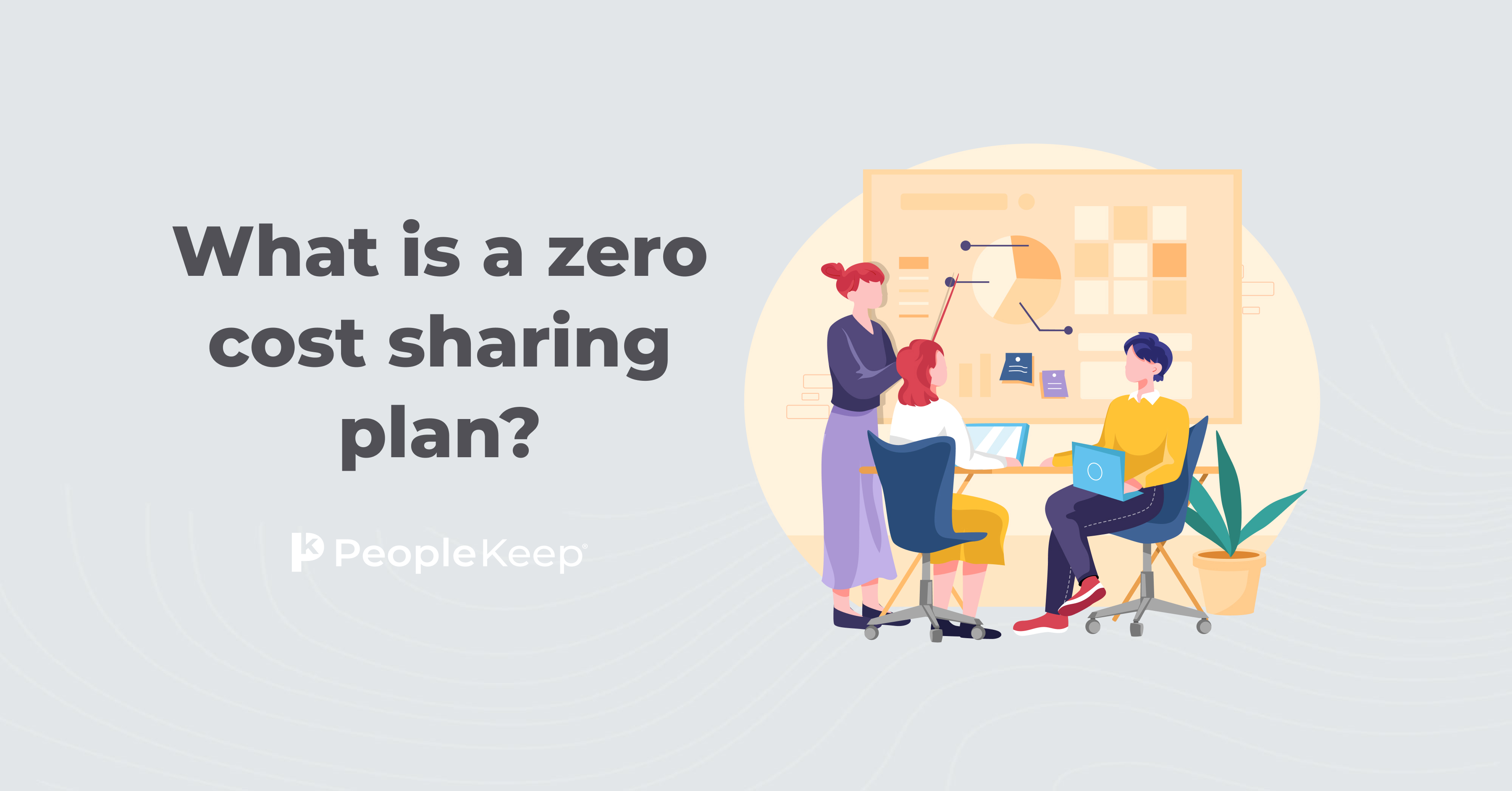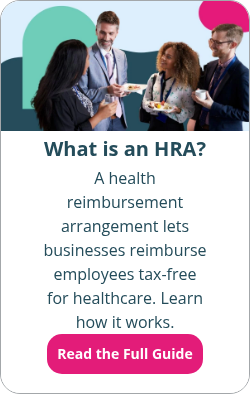Top three types of employer-sponsored health coverage
By Holly Bengfort on April 7, 2025 at 9:00 AM
Affordable health coverage ranks as the benefit U.S. employees value the most. That's why offering a quality health benefit is key in recruiting and retaining talented workers in any industry. This is especially true for small to medium-sized organizations trying to stay competitive.
Understanding all your options is key to choosing employer-sponsored coverage that fits your budget and your employees’ needs.
The article below covers three popular ways small employers can offer health benefits: group health insurance, health reimbursement arrangements (HRAs), and health stipends.
In this blog post, you’ll learn:
- Common types of employer-sponsored health coverage that can support a diverse workforce.
- The pros and cons of each health plan option including the cost of coverage and flexibility.
- How employers can choose the best health benefit for their budget and employee needs.
1. Small group health insurance
Let's start with small group health insurance. Traditional group health coverage is the most popular type of job-based health plan. KFF found that almost half of all Americans have insurance through an employer-sponsored group health plan1.
Companies with at least two full-time employees but no more than 50 can enroll in a small group medical plan. However, businesses with up to 100 employees can offer small group coverage in California, Colorado, New York, and Vermont. These plans cover the essential health benefits outlined by the Affordable Care Act (ACA) so employees can get minimum standard medical care.
If your organization has 50 or more employees, you can offer a large group health plan.
Pros of small group health insurance
Traditional group health insurance plans are widespread. So, many of your employees will already be familiar with them and how they work.
Here are some other pros of small group plans:
- The popularity of group plans makes it easy to find an insurance broker or agent to help you buy a policy. Brokers know about coverage options and can walk you through your enrollment documents.
- Employers may qualify for the small business health care tax credit. The maximum credit is 50% of premiums paid for small employers and 35% of premiums paid for tax-exempt business owners.
- Employees can enjoy cost-sharing of their monthly premium with their employer.
- In 2024, employers contributed an average of 85% of the annual premium toward self-only coverage and 75% toward family plans. Even though employers contribute less to family coverage, average contributions toward these plans have risen 60% over the past ten years. This helps to offset soaring healthcare costs and make premiums more affordable for employees2.
Cons of small group health insurance
The biggest downside of offering traditional group health insurance is its one-size-fits-all structure. The group health plan you choose must work for all employees—both young and old, healthy and high-risk. This means the plan may not work for your entire workforce.
Here are some other cons of small group plans:
- These plans aren’t as flexible as other employer-sponsored health insurance options. If you only offer one or two plan types, employees don't get to choose their provider network, annual deductible, or monthly premium.
- Group plans can be costly for employers, which can be a burden for small business owners. In 2024, the average cost of health insurance reached $8,951 for self-only plans and $25,572 for family coverage—and experts expect it to keep rising.
- Employers can be subject to annual rate hikes every year the plan is due for renewal. If you’re faced with a double-digit renewal increase, you may not be able to afford the plan anymore.
- Employer-sponsored insurance plans often have minimum contribution and participation rules. You can't offer this coverage if you don't have the budget to meet the 50% contribution requirement or have enough employees enrolled in the plan.
- They often don’t work for multi-state workforces. If you have employees spread across the country, offering a single group plan can be difficult.
2. Health reimbursement arrangements (HRAs)
Next, let's look at HRAs. These are excellent options to manage healthcare costs. An HRA is a formal employer-funded health benefit. With it, you can reimburse employees for out-of-pocket medical expenses, individual health insurance premiums, or both, depending on the type of HRA you offer.
An HRA allows small employers to control their health spending by setting their own budget. You choose a monthly allowance of tax-free money for your employees and reimburse them for qualifying healthcare purchases after you approve their claim documentation.
Three of the most popular types of HRAs are:
- Individual coverage HRA (ICHRA)
- An ICHRA is an alternative to group coverage for organizations of all sizes. It has no contribution limits and or minimum participation rates. You can also set different classes to vary employee eligibility and allowances.
- Qualified small employer HRA (QSEHRA)
- A QSEHRA is a simple, controlled-cost alternative to group health insurance for employers with fewer than 50 full-time equivalent employees (FTEs). This HRA has no minimum contribution limits, but the IRS does set annual maximum limits.
- Group coverage HRA (GCHRA), also known as an integrated HRA
- A GCHRA supplements employer-sponsored group plans. It helps employees pay for out-of-pocket costs due to gaps in coverage, such as copays, coinsurance, and deductibles. However, you can’t reimburse premiums with a GCHRA. Like the ICHRA, it has no annual limits and allows employee class customization.
Pros of health reimbursement arrangements
Employees benefit from an HRA by getting a personalized benefit that meets their unique healthcare needs. Unlike an employer-sponsored group health plan, an HRA allows every single employee to use the benefit differently and choose an individual insurance plan and provider network that works for them.
Other pros of HRAs include:
- With an HRA, you can decide how much of an allowance to offer your employers. This gives you a fixed cost you can rely on and budget for every year with no annual rate hikes.
- If your covered workers don't use their full allowance at the end of the year, the funds stay with you.
- HRAs are tax-advantaged for you and your staff. Reimbursements are tax-deductible and free of payroll taxes for employers. They’re also income-tax-free for your participating employees.
- HRAs are easy to set up and manage with the help of an HRA administrator. When you use HRA administration software like PeopleKeep by Remodel Health, you'll only need about five minutes each month to administer the benefit.
Whether your organization is big or small or has a tight or flexible budget, there's a unique type of HRA for every employer.
Cons of health reimbursement arrangements
Even though they’re becoming more popular, your employees may be unfamiliar with reimbursement models like HRAs. You must inform your eligible workers about how an HRA works, what expenses qualify, and where to shop for individual health coverage.
On the employer's side, some organization owners can't participate in their HRA. This will depend on what type of organization you run. For example, C corporation owners can use their HRA, but S corporation owners can't.
Lastly, QSEHRAs can coordinate with premium tax credits. But it takes some effort to be compliant. With a QSHERA, employees with an unaffordable allowance must reduce their premium tax credit by their allowance amount. Those with an affordable allowance can’t claim any tax credits.
For an ICHRA, those with an unaffordable allowance must opt out of the benefit to collect their subsidy. Employees with an affordable ICHRA can’t claim any tax credits. Employees must understand these rules before participating in their HRA.
Luckily, you don’t have to navigate these hurdles alone. By partnering with PeopleKeep, we’ll help you and your employees adjust to your new HRA, including:
- Sending resources that will help your employees understand their new health benefit plan.
- Walking employees through which expenses qualify for reimbursement
- Reviewing reimbursement documentation to ensure they follow IRS guidelines
- Helping your staff shop for individual health plans that meet their specific needs
3. Health stipends
Some smaller employers who don't offer health benefits consider giving employees a raise or salary bonus as an informal strategy for employer-provided health insurance. Employees can use the extra money to cover their health needs that their company isn't covering. But there’s a more streamlined benefit option.
Instead, you can provide your employees with a health stipend. A health stipend allows you to give your staff a monthly allowance for their medical costs. Employers commonly do this through a paycheck increase, a benefits card, expense reimbursement, or a lifestyle spending account (LSA).
While a stipend is taxable income and works like a bonus or raise, it offers more flexibility and gives you complete control over the benefit.
Pros of health stipends
A health stipend is an excellent option for small businesses looking to provide a benefit to employees without the compliance or restrictions of formal employer-sponsored health coverage such as group health insurance or HRAs.
Some other pros of health include:
- Healthcare stipends are informal benefits. So you can customize them any way you wish. For example, you can choose only to allow your insurance premium costs as qualified expenses. Or, you can expand eligible items beyond what the federal government allows for HRAs.
- You set the maximum monthly allowances for your employees, allowing you to set your budget without annual rate increases.
- You can offer stipends to more types of employees than you can health insurance or HRAs, such as 1099 contractors and international employees.
- If any of your employees receive advance premium tax credits (APTC), stipends allow them to take advantage of both benefits instead of choosing one over the other.
- You can offer a health stipend alongside other formal benefits, such as an HRA or group coverage.
Cons of health stipends
Stipends have many advantages, but they do have downsides. For instance, if your workers see stipends as additions to their wages, they may not view them as a meaningful benefit that provides enough value compared to an HRA or group health coverage.
Below are a few other cons of health stipends:
- By law, you can't ask employees to submit proof of insurance or receipts for the expenses listed in IRS Publication 502, whereas an HRA requires this information3. This means you can’t ensure your employees are using their stipend on medical services.
- You’ll miss out on the tax savings associated with offering pre-tax contributions to your employees' HRA allowance or covering a part of their group health insurance premium.
- Since a stipend isn't a formal health benefit, it doesn't satisfy the ACA's employer mandate. If you have 50 or fewer FTEs, you aren't required to offer health insurance coverage. But, you will be as your company grows. If you continue offering only a healthcare stipend instead of switching to a group health insurance policy or an HRA, you'll be noncompliant and must pay a penalty.
- Employers must pay payroll taxes on stipend contributions, while workers see their reimbursements added to their W-2s as extra wages. This means employees must pay income taxes on their stipend benefits.
Conclusion
Whether it's your first time offering employee health benefits or you're looking to change up your strategy, taking the time to understand your plan options is the first step to finding a plan that's right for your business. The energy you put in now will more than pay for itself in the employees you can recruit and retain through your quality health benefits package.
If you're ready to offer your employees a flexible health benefit, PeopleKeep by Remodel Health has a solution. Our personalized benefits administration software makes setting up and managing your HRA or health stipend easy.
Schedule a call with us today to see how a customized health benefit can support your employees!
This blog article was originally published on May 21, 2021. It was last updated on April 7, 2025.
1. 2024 Employer Health Benefits Survey
Check out more resources
See these related articles

How to set your first HR department up for success
Learn what an HR department is and how to set up your first one for success. Discover key roles, tools, and strategies to support your growing team.

What is a zero cost sharing plan?
In this blog, we go over what zero cost sharing plans are and what other health benefit options exist for those who don’t qualify.

Health insurance reimbursements: What are the options?
Explore your options for health insurance reimbursement. Understand what insurance reimbursement means and how HRAs can support employees.



